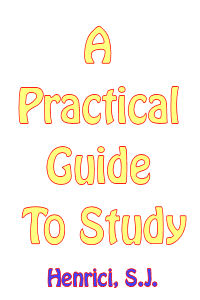
|
Posted May 21, 2005
For all who do on-going education, or who are contemplating higher studies, this little book is a valuable resource. It is also of great value to those teaching a course, or who are involved in adult education. We would also recommend the classic book How To Read A Book by Mortimer Adler. Our reading habits should never be taken for granted, but always improved. They are of the essence if ministry is to be effective. Book: A Practical Guide To Study Author: Peter Henrici, S.J. Editrice Pontifica Universita Gregoriana, Roma, pp.128 An Excerpt from the Introduction:
Our methodological counsels are therefore directed in the first place to beginners, with the aim of helping them overcome the initial consternation and of making their study more profitable from the very beginning. However, some of the bibliographical indications and techniques of research described within certainly go beyond the needs and even the capacities of a beginner, for we would like that this methodological “primer” be useful also to the more advanced student. An Excerpt from the Book: How should one read? Read actively. It is not enough to pick up some ‘impression’ from the book; one must instead reconstruct for oneself what the author is saying, re-eliciting in one’s own mind the ideas that the author had in his. For this, one must: Read with a certain ‘preconception’, i.e., with some idea of what the book is dealing about and how it proceeds, in such a way that one expects from the reading an answer to define questions. To this end, one must first study the Table of Contents. Follow the order of the book itself, because only in this way will one follow the argument of the author. Sometimes, it is true, one must go ahead without having understood everything, because certain passages become clear only in the light of what will be said later in the book; one can then return to what was unclear. Read slowly and attentively, i.e., with a rhythm that allows one to follow the argument thoughfully. “When one reads too fast or too slowly one follows nothing” (Pascal). Every now and then there is needed a brief pause to recapitulate the argument. Read dialoguing with the author, as with the professor during the lectures, i.e., taking his affirmations on the one hand with a certain critical reserve, and on the other hand allowing one’s own preconceptions to be modified and corrected by the reading. Write while reading, taking note of what one has understood during the reading, as well as of the reflections that occur while reading. Therefore, while reading, one must always have at hand paper and pencil or pen, so that one can construct a “materialized memory” of the fruits of the reading. Four types of notes can be made: Notes in the margin of the book, as in the textbook, but obviously that can be done only when the book is one’s own, and never in those borrowed from the library or from others! In a second (or third) reading of the book one can then refer directly to the passages marked as important. In books borrowed for a sufficient length of time, the most important passages can be marked with a bookmark, and later notes can be made. A specialized index of points which are of particular interest, noting down on a large paper the names or notions which have to do with the problem one is dealing with (in written work or dissertation), together with the page references. At the end one could compile an alphabetical index (if useful) simply by cutting the paper and arranging the items in alphabetical order. A continuous summary of the whole book or of some chapter, on large size pages (or notebook), somewhat like the notes taken in class. This is not a question of copying or even abbreviating whole passages of the book, but of writing down what one has understood of what the author is saying. Such a summary allows one to recapitulate the whole book rapidly, and can constitute ready material for a “report” or for the “summary” part of a written work, or even for certain chapters of a “dissertation.” Notes on cards for conserving information, ideas, formulations or one’s own reflections which seem particularly relevant, whether for the work in hand or for any other future use (e.g., catechesis, courses to be given, etc.). While the other three types of annotations are a help and an extension of my understanding of what I read, the notes on cards conserve the material for future use, perhaps in a manner which has little to do with the present reading of the book. The advantage of cards is that, since each one contains only a single point, they can be ordered and regrouped as one likes. Table of Contents: Part 1: The course and the textbook Part 2: Group work Part 3: Study for assimilation Part 4: Creative study Part 5: Initiation to research |
|
